Sandown
Sandown is a seaside resort and civil parish on the south-east coast of the Isle of Wight, United Kingdom with the resort of Shanklin to the south and the settlement of Lake in between. Together with Shanklin, Sandown forms a built-up area of 21,374 inhabitants.[1]
| Sandown | |
|---|---|
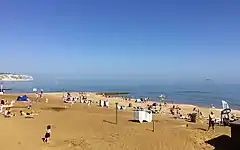 One of Sandown's sandy beaches | |
 Sandown Location within the Isle of Wight | |
| Population | 11,868 (2011 Census) |
| OS grid reference | SZ600843 |
| Unitary authority | |
| Ceremonial county | |
| Region | |
| Country | England |
| Sovereign state | United Kingdom |
| Post town | SANDOWN |
| Postcode district | PO36 |
| Dialling code | 01983 |
| Police | Hampshire |
| Fire | Isle of Wight |
| Ambulance | Isle of Wight |
| UK Parliament | |
The northernmost town of Sandown Bay, Sandown has an easily accessible, sandy shoreline with beaches that run continuously from the cliffs at Battery Gardens in the south to Yaverland in the north.
Geography
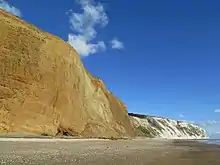



The town grew as a Victorian resort surrounded by a wealth of natural features.
The coastal and inland areas of Sandown are part of the Isle of Wight Biosphere Reserve designated by UNESCO's Man and the Biosphere Programme in June 2019,[2] and Sandown's sea front and clifftops form part of the Isle of Wight Coastal Path.
The Bay that gives Sandown its name is an excellent example of a concordant coastline with five miles of well-developed tidal beaches stretching all the way from Shanklin to Culver Down due to Longshore drift.[3] This makes Sandown Bay home to one of the longest unbroken beaches in the British Isles.[4]
To the north-east of the town is Culver Down, a chalk down accessible to the public, mostly owned and managed by the National Trust. It supports typical chalk downland wildlife, and seabirds and birds of prey which nest on the cliffs.
Nearby are Sandown Levels in the flood plain of the River Yar, one of the few freshwater wetlands on the Isle of Wight, where Alverstone Mead Local Nature Reserve is popular for birdwatching. Sandown Meadows Nature Reserve, acquired by the Hampshire and Isle of Wight Wildlife Trust in 2012, is a place to spot kingfishers and water voles.[5] Further inland, Borthwood Copse provides delightful woodland walks, with bluebells aplenty in the Spring.
The area's marine sub-littoral zone, including the reefs and seabed, is a Special Area of Conservation. At extreme low tide, a petrified forest can be revealed in the northern part of the Bay, and fragments of petrified wood are often washed up.
History
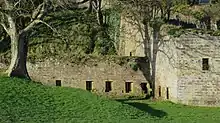


Before the 19th century, Sandown was on the map chiefly for its military significance, with the Bay's beaches feared to offer easy landing spots for invaders from the Continent.
It is the site of the lost Sandown Castle. While undergoing construction in 1545, the fortification was attacked during the French invasion of the Isle of Wight when invaders fought their way over Culver Down from Whitecliff Bay before being repelled. The castle was built into the sea, prone to erosion and demolished fewer than a hundred years after it was built. In 1631, the castle was replaced by Sandham Fort [6] built further inland. In 1781, the fort's complement consisted of a master gunner and over twenty soldiers.[7] Sandham Fort was demolished in the mid-19th century and is now the site of Sandham Gardens.
In the 1860s, five Palmerston Forts were built along the coast of Sandown Bay, including Granite Fort at Yaverland, now the Isle of Wight Zoo. On the town's western cliffs Sandown Barrack Battery survives as a scheduled monument and Bembridge Fort, where the National Trust offers tours, can be seen on the downs to the north-east.[8]
One of the first non-military buildings was Sandham Cottage or 'Villakin', a holiday home leased by the radical politician and one-time Mayor of London John Wilkes in the final years of the 18th century.[9] See 'Sandown's famous connections' below.
The arrival of the railway in 1864 saw Sandown grow in size, with the town's safe bathing becoming increasingly popular. In the summer of 1874, the Crown Prince Frederick and Princess Victoria of Germany, their children and entourage rented several properties in the town and took regular dips in the Bay.[10] Sandown's pier was built in the same decade, opening in May 1878, and extended in length in 1895.
The town laid further claim to becoming a fashionable English resort when the Ocean Hotel opened in 1899. The brainchild of West End theatrical impresario Henry Lowenfeld, the Ocean built on to and swallowed up the town's previous hotel of choice, the King's Head. For the new hotel's inauguration, a large number of dignitaries were invited from London, arriving in Sandown from Portsmouth by special boat. Guests had the chance to explore Sandown in coaches and carriages, and the hotel servants were all dressed in uniforms 'like admirals and post-captains' [11]
Sandown's destiny in the 20th century was to become a favourite bucket-and-spade destination for all classes. The Canoe Lake was opened in 1929 by the author Henry De Vere Stacpoole followed in 1932 by Browns Golf Course (see below). The Art Deco Grand Hotel, opened next door to Browns in April 1938, is now closed with planning permission for demolition granted in 2014.
Today, Sandown's esplanade has a mixture of former Victorian and Edwardian hotels with modern counterparts overlooking the beach and the Bay. A new Premier Inn is due to open in 2021. Sandown Pier has an amusement centre with arcade games, children's play areas and places to eat and drink. The pier's former landing stage is used for sea fishing.
Further north is the Isle of Wight Zoo run by The Wildheart Trust.[12] Established as Sandown Zoo in the 1950s, it was acquired by the Corney family in the 1970s and today specialises in rescued tigers and other big cats. Nearby is the purpose-built Dinosaur Isle palaeontology centre which opened in 2001, and Sandham Gardens [13] which offers a dinosaur miniature golf course, play parks for children and young people, and bowls.
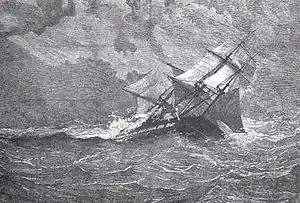
HMS Eurydice
On 24 March 1878, the Royal Navy training ship HMS Eurydice (1843) capsized and sank in Sandown Bay with the loss of 317 lives, one of Britain's worst peacetime naval disasters. The tops of the vessel's sunken masts were still visible from Sandown two months later on the day the town's pier was opened [14]
HMS Eurydice was refloated in August and beached at Yaverland to be pumped out, the subject of a painting by Henry Robins (1820-1892) for Queen Victoria who came over from Osborne House with other members of her family to see the wreck.[15]
There is a memorial to crew of the Eurydice in the graveyard of Christ Church, Sandown.

Town hall
Commissioned and built by the Sandown Local Board in 1869, the Grade-2 listed former Town Hall is situated in Grafton Street. The building also became the home of Sandown Fire Brigade, with a two-storey extension added by the early 20th century.
The Town Hall's stage was home to the Sandown Amateur Operatic and Dramatic Society founded just before World War I.[16] For many decades, the building was Sandown's principal venue for musical concerts, political meetings and civic events.
The present-day Sandown Town Council no longer use the building and moved to new headquarters in 2018. The fire brigade also occupies new premises on the fringe of the town.
Brown's Golf Course
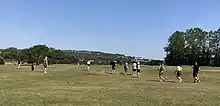
Designed by one of the UK's leading players of the time Henry Cotton (golfer), the Brown's pitch and putt courses were the idea of south London pie and sausage maker Alex Kennedy. Opened on Sandown's eastern sea front in March 1932, the original clubhouse had the motto 'Golf for Everybody' emblazoned on its roof.[17] Brown's and its ice cream factory were adapted in the 1940s to disguise pumping apparatus for Pipe Line Under the Ocean (PLUTO) intended to deliver oil to the D-Day beaches. The courses remained popular with all ages in the 21st century, but closed in September 2020 with the Isle of Wight Council reported to be considering development on the site.
Sandown Carnival

The town's summer carnival has been entertaining visitors since 1889. Today's organisers put on a series of events including the popular Children's Carnival and Illuminated Carnival, as well as New Year's Day Celebrations with entertainment and fireworks.
Since 2017, another popular Sandown get-together called Hullabaloo [18] has been held over a weekend in May, organised by Shademakers UK Carnival Club in collaboration with educational organisations, musicians, businesses and charities.
Eating and drinking
Sandown offers an assortment of restaurants, cafes, bars and pubs along the sea front and in the town. They include the restored Bandstand restaurant on Culver Parade [19] with sweeping views of the Bay. Family-friendly 'gastro-pubs' include The Caulkheads in Avenue Road.[20] Boojum and Snark at 105 High Street, opened in 2019 and inspired by author Lewis Carroll who stayed across the road in the 1870s, is the town's first sustainable microbrewery offering craft beers and ciders, and art exhibitions.[21]

Transport






Sandown railway station is on the Island Line Railway, the Isle of Wight's one remaining public line from Ryde Pier Head to Shanklin.
Sandown is also served by buses run by Southern Vectis on routes 2, 3 and 8 with direct services to Bembridge, Newport, Ryde, Shanklin and Ventnor. Night buses are run on Fridays and Saturdays, along route 3.[22]
Media location
The UK group Take That filmed the video for their fifth single I Found Heaven on Sandown's beaches and sea front in 1992 [23]
Sandown High School and locations nearby were used in the 1972 film That'll Be The Day starring David Essex, Ringo Starr, Billy Fury and Rosemary Leach.[24]
The TV series Tiger Island on ITV and National Geographic in 2007 and 2008 [25] chronicled the lives of the more than twenty tigers living at Isle of Wight Zoo.
Twin towns
Sandown had a twinning (jumelée in French) arrangement with the town of Tonnay-Charente in the western French département of Charente-Maritime although the relationship was reported to be 'in tatters' in 2002.[26] Sandown has also been twinned with the United States town of St. Pete Beach, Florida.
Namesakes
- The town of Sandown and its Bay have inspired the naming of a number of Sandowns around the world, including Sandown, New Hampshire USA, Sandown, Gauteng a suburb of Johannesburg in South Africa, and Sandown Bay in South Africa's Western Cape. The former industrial area of Sandown on the Parramatta River, New South Wales, Australia was commemorated by the Sandown railway line in the western suburbs of Sydney, which ceased passenger services in 1991.
- HMS Sandown, launched in 1988, was the name ship in the Sandown class of mine countermeasures vessels. Its earlier namesake was the paddle steamer and passenger ferry PS Sandown which saw wartime service as a minesweeper.
Notable people
- John Wilkes (former Lord Mayor of the City of London) stayed regularly in Sandown in the late 18th century at the place he called 'Villakin', also known as Sandham Cottage. A memorial plaque marks the site of the cottage close to the present-day High Street. On Sunday mornings, Wilkes would go to Shanklin Church, and after the service would walk across the fields to Knighton with David Garrick and his wife.[27]
- Naturalist Charles Darwin worked on the abstract which became On the Origin of Species when staying at Sandown's King's Head Hotel in July 1858. He and his family later moved on to Norfolk House in nearby Shanklin.[28] Darwin also visited the Isle of Wight on other occasions, and was photographed there by Julia Margaret Cameron in 1868.[29]
- The writer George Eliot (Mary Ann Evans) stayed in Sandown during a two-week visit to the Isle of Wight in June 1863, having recently published her novels Romola and Silas Marner. Her celebrated work Middlemarch was published nine years later.[30]
- Frederick III, German Emperor and his consort Victoria, Princess Royal, when Crown Prince and Princess of Germany, stayed at Sandown with their children for two months in the summer of 1874. Queen Victoria travelled from Osborne House to visit them on 31 July, an event she described in her journals [31]
- The author Lewis Carroll, the Reverend Charles Lutwidge Dodgson, spent successive summers on Sandown sea front in the 1870s, staying first at the King's Head Hotel and later at Culverton House. In 1875, while he was writing The Hunting of the Snark, he met 9-year old Gertrude Chataway whose family was staying next door. The first edition of The Hunting of the Snark is dedicated to Gertrude.[32]
- The composer Richard Strauss (1864-1949) spent summer holidays at Sandown's Ocean Hotel in 1902 and 1903. His sketchbooks show that, while there, he worked on his Symphonia Domestica and themes that found their way into Der Rosenkavalier [33]
- Sir Isaac Pitman worked on his system of shorthand in Sandown in the 1860s [34]
- Cilla Black, Frankie Howerd, Tommy Cooper, Jimmy Tarbuck and Dickie Henderson were among the late 20th century performers doing summer seasons at Sandown Pier Pavilion [35][36]
- Oscar-winning film director and playwright Anthony Minghella was a pupil at Sandown High School [37] Members of the groups Level 42 and the Bees also went to Sandown High School and began their musical careers in Sandown.
- Edward Upward (1903-2009) long-lived author and part of the Auden Group in the 1930s, lived in Sandown from 1961 to 2004 [38]
- James Clutterbuck, cricketer
- William Darwin Fox, naturalist-clergyman, second cousin of Charles Darwin buried in Sandown.
- James Dore (1854-1925), a photographer who recorded hundreds of late Victorian and Edwardian images of Sandown and the Isle of Wight. The Isle of Wight Heritage Service holds a collection of his work [39] Dore was also a local councillor, Justice of the Peace and Sandown's Chief Fire Officer [40]
- Thomas Field Gibson FRG found some important fossils while staying at his beach house at Sandown.[41]
- Eric Charles Twelves Wilson V.C. was born in Sandown.
- Simon Moore, footballer who plays for Sheffield United.
- Mary Ellis, ATA Pilot 1941-1945, later managing director of Sandown Airport. Mary died in July 2018 aged 101 [42]
See also
References
- Department for Environment, Food & Rural Affairs 2014, built-up areas identified as hub towns
- UNESCO description of the Isle of Wight Biosphere Reserve
- "Isle of Wight Shoreline Management Plan 2" (PDF). Isle of Wight Council. December 2010.
- "Coastal Communities Economic Plan, Sandown Bay" (PDF). Coastal Communities Alliance. May 2016.
- Sandown Meadows Nature Reserve web page
- A brief history of Sandham Fort, Island Eye
- History of the Isle of Wight by Sir Richard Worsley, 1781
- Bembridge Fort and Downs, the National Trust
- Wilkes, John; Almon, John (1805). The correspondence of the late John Wilkes: with his friends, printed from ... - John Wilkes - Google Books. Retrieved 17 September 2013.
- The Isle of Wight Chronicle, Thursday 30 July 1874 'No greater recommendation can be given to the excellent bathing facilities possessed by Sandown than recording the fact that the members of the Imperial family take every possible advantage of them by bathing almost daily...'
- 'The Ocean Hotel, Sandown' Isle of Wight Observer, Saturday 20 May 1899
- The Wildheart Trust and its mission statement
- Sandham Gardens website
- The Hampshire Advertiser County Newspaper p8, 1 June 1878
- The Wreck of the Eurydice, Royal Collection Trust
- 'Sandown Operatic and Dramatic Society', a review of HMS Pinafore, Isle of Wight County Press, 20 April 1912
- http://www.sandowntowncouncil.gov.uk/_UserFiles/Files/History/Issue%2091-%2092%20SAUSAGES%20AND%20GOLF.pdf
- Hullabaloo IoW on Facebook
- Bandstand Restaurant website
- The Caulkheads website
- Boojum and Snark join Beer and Buses this weekend, On the Wight, 8 October 2019
- "Southern Vectis route list". Southern Vectis. Archived from the original on 30 November 2009. Retrieved 22 December 2009.
- Take That's 'I Found Heaven' video on YouTube
- That'll Be The Day locations on Reelstreets
- Athena Films, Tiger Island
- Frenchman 'used town twinning for cheap holidays', Daily Telegraph 19 April 2002
- John Wilkes on the Isle of Wight by Jan Toms, JanTomsBriefBiographies, July 2018
- Darwin Correspondence Project, letter to W D Fox, 21 July 1858.
- Charles Darwin by Julia Margaret Cameron, V&A Collection
- Project Gutenberg's George Eliot's Life, Vol. II (of 3), by George Eliot
- Queen Victoria's Journals, entry for 31 July 1874
- Lewis Carroll, A Portrait With Background by Donald Thomas (Chapter 10 'Dreaming as the Summers Die'), John Murray, 1996 ISBN 0-7195-5323-7
- Richard Strauss: Man, Musician, Enigma by Michael Kennedy, Cambridge University Press 1999 ISBN 9780521027748
- The Life of Sir Isaac Pitman (Inventor of Phonography) by Alfred Baker p172, Sir Isaac Pitman & Sons 1919
- John Hannam archive interview with Frankie Howerd in 1980 about working on the Isle of Wight (25 mins of audio)
- IoW Beacon feature about Sandown Pier and its performers, June 2017
- Tributes to Anthony Minghella, BBC Hampshire and Isle of Wight, 28 October 2014
- Renegade in Springtime by Rod Mengham, Times Literary Supplement, March 22nd 2017
- The photographs of James Dore, Isle of Wight Council Heritage Service
- Profile of James Dore by the Isle of Wight Fire Brigades Federation
- "Thomas Gibson & Thomas Field Gibson". Dictionary of Unitarian and Universalist Biography. Retrieved 20 November 2017.
- Mary Ellis obituary, The Guardian, 29 July 2018
External links
| Wikivoyage has a travel guide for Sandown. |
- Sandown Visitor Information
- Sandown Carnival website
- Hullabaloo website
- Our Sandown, Facebook history group
- Sandown HUB, Facebook group for local news and information
- Official website of Sandown Town Council
| Wikimedia Commons has media related to Sandown. |
- . Encyclopædia Britannica. 24 (11th ed.). 1911.
- Official website of the Isle of Wight Council
